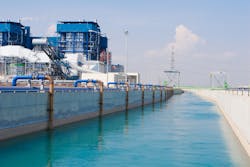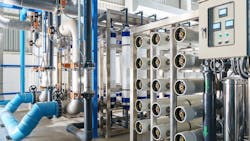Achieving Water Sustainability Goals With Advanced Analytics
Water is one of our most vital natural resources. While it is essential for all forms of life, water also is necessary for a variety of industrial processes that create products to improve life. Today, the manufacturing industry is a primary water consumer. Demand is expected to rise.
Failure to manage water and wastewater use properly can affect the environment negatively and cost companies millions in regulatory fines. Water treatment processes also are energy-intensive. Global, national, and regional regulations increasingly challenge companies to adhere to water use and discharge regulations, and to reduce their energy consumption.
Industry 4.0 and digital transformation initiatives have made assessing water quality easier. Companies are gaining tangible insights from their collected process data with self-service analytics solutions. The data, stored in what is known as a historian, includes information about process behavior. It also provides details about process anomalies that could lead to water quality or energy use issues over time.
An Inside View: Water and Wastewater
Water and wastewater quality is important for almost all manufacturers. Specific requirements vary by industry and intended use.
At some point, companies must address used process water that is not fit for release into the sewerage system or the environment. Wastewater byproduct is another industrial water use challenge. Some companies invest in water recycling systems, while others treat the water before discharging it safely back into the environment.
However, treating water requires extreme high-volume flows that need large, energy-intensive plants. Water treatment plants use pumps and treatment options that can put a dent in a company’s sustainability program. Furthermore, to ensure water quality regulatory mandates – which can as low as a few nanograms of effluents per liter — process experts must use advanced separation techniques.
Assessing Process Data
Raw process data can be impossible to interpret without the help of a data scientist. Unfortunately, data scientists are not always available. When they are, they might not be as familiar with processes to run an analysis. Engineers could spend significant time explaining the process to the data scientist so he or she could crunch numbers.
Self-service data analytics empower process engineers to analyze raw data as time-series data without the help of a data scientist. When process experts can make data-driven decisions, they help increase overall equipment efficiency (OEE), improve the quality of water and wastewater, and contribute directly to a company’s sustainability goals.
By looking at these trends over time, process experts can create a golden fingerprint that establishes ideal parameters from collected process data. They then can set up monitoring systems and alerts to inform key stakeholders that an unwanted event has occurred when limits fall outside of the ideal range.
Lab Analysis with Live Process Data
Monitoring concentrations of wanted or unwanted substances in the water is essential. Online concentration measurements often are complex and expensive. For some substances, they can be difficult or impossible to measure. Therefore, many parameters of wastewater monitoring often are not available as live process data but are determined by sampling and lab analysis. Lab analyses can take hours or days. As a result, plant operators do not receive the analysis until it is too late to adjust the process operation.
By correlating lab analysis results with available live process data, process experts can overcome these obstacles. The correlation also enables process experts to see when an event may happen again so they can adjust accordingly.
For example, a chemical company in the Netherlands wanted to review the correlation between various process and wastewater parameters. Process engineers especially were interested in what factors were influencing the concentration of organic acids.
The company deployed a self-service data analytics solution to identify the correlation between the different parameters. Because organic acid concentrations were not part of the company’s historian, the first step of the solution was to import the lab reports. This allowed the process engineers to evaluate the lab concentration measurements as time-series data.
Second, engineers needed to find influence factors for the organic acid concentrations. In this case, the redox value, available as live process data, was expected to have an influence on these organic acid concentrations. The influence factor functionality of the analytics solution allowed linear regression to correlate multiple parameters simultaneously. Process experts used this function to search for parameters that explained acid concentrations. The company also used the solution’s time-shift function to search for optimal correlation.
Process experts determined there was a clear correlation between the redox value and the n-butyric acid concentration five days later. They also found a correlation with other organic acids. With this knowledge, process engineers learned they could use the redox value to determine the acid concentration and proactively intervene if the water quality was not optimal.
Using this approach, the company saved time, money, and ensured compliance with quality standards.
Effluent Quality Monitoring and Reporting
A Canadian mining company operates with strict government regulations about the quality of water that its operations discharge into the environment. The average flow rate and pH value of effluents (liquid waste discharged into a river or the sea) must be reported monthly to government officials.
The plant that cleans the company’s process wastewater shut down frequently. When a shutdown occurred, the pH reports showed sharp peaks and drops, which lead to inexact average calculations in the overall pH of the discharged wastewater.
Engineers had been using a spreadsheet to evaluate the minimum and maximum pH values each day and manually removing the values if they appeared to be incorrect. The company opted to move to an advanced self-service analytics solution to smooth out the fluctuating pH levels.
Process experts created new tags and filters in the self-service solution so they could see relevant data without other values interfering. They extracted the average, minimum, and maximum values of the pH over time and created contextual models to find events where the pH level was excessive.
With the advanced solution, the mining company saved a view of the corrected flowrates and pH values. Now, process experts can see a comparison table that shows all relevant and correct pH levels during a month. They also can send the table as a report to the Canadian government and remain in compliance.
The mining company saved time and achieved greater sustainability while complying with regulatory requirements quickly.
The Road to Digital Transformation
Companies go through a series of technical advancements over time. Each phase demonstrates a growing digital, and even analytical, maturity. Plants evolve from a state of capturing data to analyzing it for continuous improvements.
While some industries have moved more quickly in their digital transformation journey, the water and wastewater industries have been slower to adapt. Analyzing water and wastewater process data not only contributes to sustainability and energy efficiency, but it also optimizes processes and improves the quality of production.
A self-service data analytics solution allows process engineers to manage by exception. They can view time-series data, create an ideal profile, and monitor for events that may occur outside the scope of the ideal profile.
The result is an approach that provides transparency, saves time, cuts expenses, reduces potential environmental fines, and contributes to overall plant sustainability.
About the Author
Charlotte Fischer
Customer Success Manager
Charlotte Fischer is a customer success manager at TrendMiner where she helps companies and software users become successful with their self-service analytics programs. She previously was a project engineer at Blücher GmbH, where she specialized in water treatment with activated carbon. Charlotte earned a master's degree in Biochemical Engineering at TU Dortmund and an MBA with a focus on Process, Quality, and Digital Change Management at FOM Cologne.

